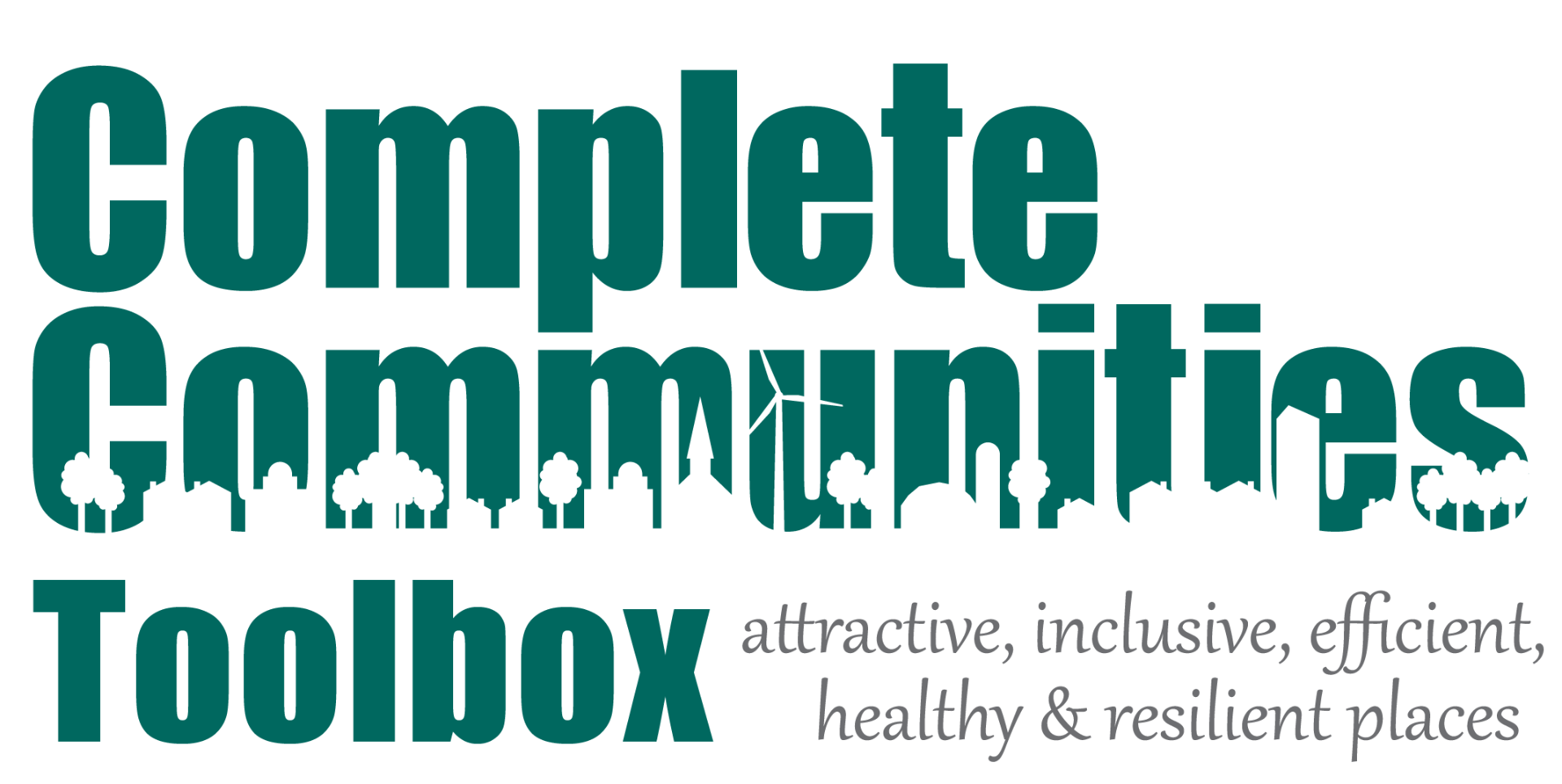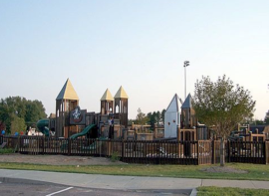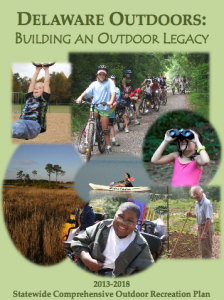This section, and video on Parks and Recreation Master Planning, describes the process and benefits of parks and recreation master planning. Parks and recreation master planning can foster healthy communities, promote conservation and environmental stewardship, stimulate economic activity, and provide transportation equity. According to the National Recreation and Parks Association, goals of parks and recreation systems often closely align with the principles of active transportation. Therefore, local government decision makers should consider plans for infrastructure, services, and programs that serve both a recreation and active transportation purpose.
The following video, produced by DNREC, highlights the First State Trails and Pathways Initiative that sets forth a plan to create an interconnected network of shared-use trails and pathways that will support safe and affordable, non-motorized travel and recreation opportunities. The planned trail network is designed to expand connections between neighborhoods, towns, and cities to create more vibrant, active, and healthy communities.
Topics in this section include:
- Description of Parks and Recreation Master Planning
- Benefits of Parks and Recreation Facilities and Programs
- Benefits of Parks and Recreation Master Planning
- Criteria for Successful Parks and Recreation Master Plans
- Steps to Complete a Parks and Recreation Master Plan
- Common Issues with Parks and Recreation Master Planning
- Examples of Parks and Recreation Master Planning in Delaware
Description of Parks and Recreation Master Planning
Master planning is a planning technique that is used for a wide variety of projects. According to a report issued by the American Association for Leisure and Recreation, a community parks and recreation master plan is “a document that provides an inclusive framework for orderly and consistent planning; acquisition; development; and administration of the parks and recreation resources, programs, and facilities of the agency that sponsors the master plan.” According to Reiner Jaakson, the master planning process “identifies the recreation needs in the community, predicts future demand, and states policies for physical and social planning.” In essence, the purpose of a master plan is to develop a comprehensive vision for a park system, individual park, open space area, recreation facility, and/or programs in context of its location, natural resources, and visions of the community. This vision will serve as a framework for the long-term use and development of a park or facility.
Parks and recreation master planning is a comprehensive process that provides guidance and policy direction to local government decision makers. The planning process, which engages stakeholders and garners public input, provides a foundation for understanding and responding to the parks and recreation needs of a community. The process involves strategically examining a community’s vision; existing community services, facilities, and resources; and assessing future needs concerning parks, recreation, open space, and greenways.
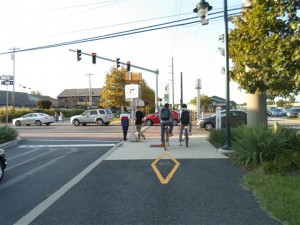
Pomeroy and Newark Rail Trail
Credit: J McGinnis, Source: Trail Link
Master plans allow a local government to assess current and future recreational needs, evaluate feasible options, develop a strategic action plan, and budget for long-term or phased-in development and improvements. Master plans lay out an organizational framework for improving parks and recreation facilities, programs, and services to better serve the public. The master plan shapes the delivery of local government parks and recreation services, programs, and activities in a manner that is consistent with a local government’s comprehensive plan and policy agenda.
Parks and recreation master planning can also shape successful communities. A 2014 roundtable sponsored by the National Parks and Recreation Association (NRPA) and the American Planning Association (APA) recognized the role of parks in economic development and revitalization, planning for health outcomes, and contributing to green infrastructure solutions. Preparing parks and recreation master plans can provide a foundation for economic development, building healthy communities, and providing a unique sense of place. The roundtable advocates the creation of a new framework for intergovernmental collaboration to develop plans, exchange ideas, and share resources.
Benefits of Parks and Recreation Facilities and Programs
Studies show that there is a link between the built environment and the physical, social, and economic health of a community. For the last half-century, we have been building vehicle-dependent environments that foster obesity, poor health, social isolation, high costs of infrastructure, and focus away from our downtown cores. Sprawling land use patterns have altered our travel behavior, lead to physical inactivity, and contributed to soaring costs for health care and investments in our transportation system. Planning for parks and recreation facilities can promote active lifestyles, build healthy communities, and lower health care and transportation costs. The National Recreation and Parks Association (NRPA) has created a presentation that highlights the many benefits of well-planned parks.
Active Transportation
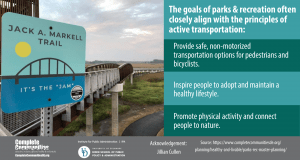 Active transportation is defined as “human-powered modes of transportation.” Traditionally, transportation polices have focused on automobiles. This has led to sprawling land-use patterns, lack of walkable infrastructure, compartmentalized built environments, less-active lifestyles, and greater incidence of chronic obesity and diseases. Planning for active transportation and parks and recreation infrastructure are complementary initiatives. Trails, pedestrian and bicycle infrastructure, and shared-use paths provide opportunities for people to walk, bike, take non-motorized transportation in safe places.
Active transportation is defined as “human-powered modes of transportation.” Traditionally, transportation polices have focused on automobiles. This has led to sprawling land-use patterns, lack of walkable infrastructure, compartmentalized built environments, less-active lifestyles, and greater incidence of chronic obesity and diseases. Planning for active transportation and parks and recreation infrastructure are complementary initiatives. Trails, pedestrian and bicycle infrastructure, and shared-use paths provide opportunities for people to walk, bike, take non-motorized transportation in safe places.
Health Benefits
A report issued by NRPA quantifies the contribution of public parks to the physical activity and health of community residents. It affirms that physical activity is critical to good health, and parks provide a venue in which physical activity can occur. In addition, a report on The Health Benefits of Parks by the Trust for Public Land provides strong evidence that people exercise more when they have access to parks. Regular physical activity can improve health and reduce the risk of diseases such as heart disease, hypertension, colon cancer, and diabetes. Exercise and active lifestyles can also provide psychological benefits, improve mental health, and alleviate symptoms of depression and anxiety.
Economic Benefits
Studies show that well-planned parks and recreation systems can serve as a catalyst for economic development. Access to parks and recreation facilities and active transportation infrastructure can increase property values, foster job creation, and provide a foundation for place-based economic development. According to a report by the NRPA and the American Planning Association (APA) on The Role of Parks in Shaping Successful Cities, parks can attract consumers to nearby downtown regions, spur the opening of local restaurants, and increase tourism. Measuring the economic benefits of well-planned parks systems can be difficult. However, the Trust for Public Land has created a guide for Measuring the Economic Value of a City Park Systemthat enumerates those benefits in terms of seven major factors—property value, tourism, direct use, health, community cohesion, clean water, and clean air.
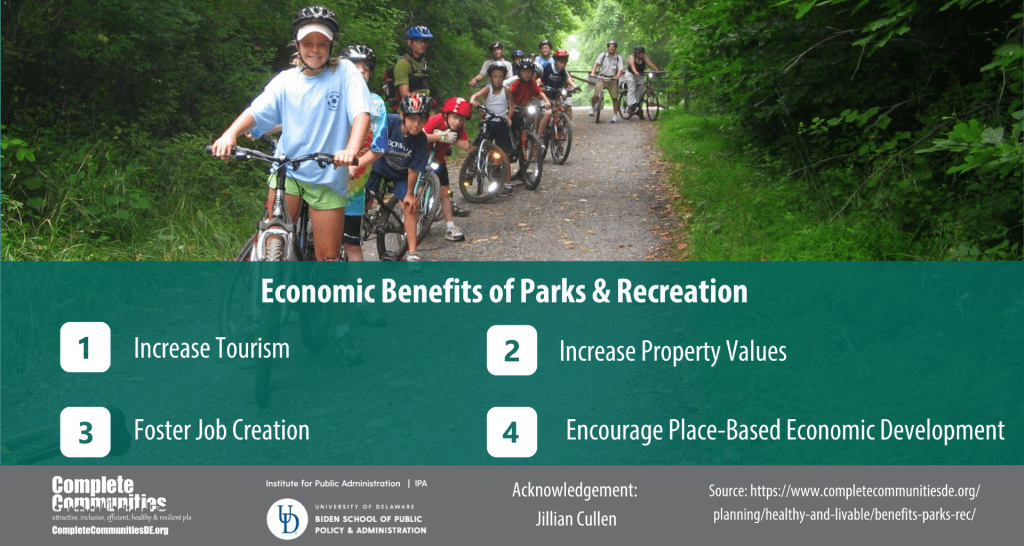
Environmental Benefits
Parks and recreation infrastructure and facilities promotes conservation and environmental sustainability. According to a report by the NPRA, parks facilities conserve natural resources and wildlife habitat, protect air and water quality, and preserve open space for current and future generations. Through stewardship activities, parks can involve the public in conservation efforts and increase awareness of environmental needs. Parks and open space conserves scenic vistas, maintains healthy ecosystems, and provides carbon‐reducing sustainable landscapes.
Social and Equity Benefits
Parks and recreation facilities also provide social and equity benefits for community members. According to an analysis of social equity and parks conducted by NPRA, public parks provide equal access to all citizens regardless of age, gender, socioeconomic status, ethnicity, or ability. Parks and recreation facilities can foster community pride, bring people together, create destination-oriented places, and connect people to each other and nature. “Pocket parks” are small outdoor spaces, often in urban areas, that provide active recreation opportunities for residents—including children—in underserved areas. According to an issue brief on pocket parks by the National Recreation and Park Association, successful parks have four key qualities. They are accessible, allow people to engage in activities, comfortable, and sociable places. These small parks may be created by transforming vacant lots, rooftops, or previously hardscaped areas along sidewalks and active transportation routes.
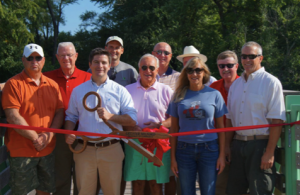
State and local officials dedicated the final phase of the Mispillion Greenway with the opening of Goat Island in 2014. The multi-phased Riverwalk project resulted in a two-mile pedestrian and bicycle path.
Credit: Terry Rogers, Source: Milfordlive.com
Benefits of Parks and Recreation Master Planning
It is important for local government leaders to understand the relationship between community parks and recreation services, economic development, and quality of life. The master planning process enables local governments to assess recreation needs and interests of community members. It enables decision makers to prioritize resource allocation decisions for new facilities and rehabilitation projects, programs, and services in a manner that is fiscally responsible, environmentally sound, publicly supported, and politically prudent.
A report produced by the Project for Public Spaces cites several benefits of the parks and recreation master planning process. It notes that good master plans must be flexible and involve stakeholders from the onset. Master plans can provide a foundation for:
- Building credibility, support, and consensus from community members and stakeholders
- Informing citizens about a park’s needs and its community assets
- Identifying capital improvement goals that are needed to assess fiscal requirements and fundraising needs
- Guiding critical decisions about parks and recreation facilities, infrastructure, programs, and services
- Developing recommendations and an implementation strategy
In addition to providing a design blueprint for facilities, the master plan can be used as a promotional document to foster support and political involvement. A successful master planning process will transform a community’s vision into tangible plans to create outstanding recreation opportunities, well-maintained facilities, and a customer-focused and responsive park system.
Criteria for Successful Parks and Recreation Master Plans
Collaborative Process
According to a Project for Public Spaces’ report, good master plans “represent(s) a vision that brings together the concerns of different interest groups, and their recommendations create a ground swell of community and political support.” An effective master plan is the result of a collaborative effort that solicits and incorporates input from a diverse group of local government leaders, staff members, citizens, and stakeholders.
Key Aspects
According to the resource guide section of IPA’s Healthy Communities: A Resource Guide for Delaware Municipalities publication, successful master plans must be financially feasible, environmentally compatible, balanced, technically sound, responsive and flexible. The plan should describe how it is or will:
- Be consistent with and/or advance the goals of local, county, regional, and state plans;
- Be responsive to the interests of citizens and diverse groups of stakeholders;
- Implementable, lead to a shared vision for community livability, and provide recommendations for land-use policy, parks development and rehabilitation, and natural resource conservation;
- Be adaptable to future changes in conditions;
- Lead to a shared vision for recreation and conservation among all stakeholders and guide future implementation;
- Address needs based upon the demographics of the community/region, including low- income, minority, and special-needs populations;
- Address the need for ADA accessibility (e.g., facilities, sites, and programs);
- Create opportunities for citizens to connect to open space, greenways, parks, and conservation areas;
- Strengthen connections between recreation, healthy lifestyles, and economic benefits in communities;
- Reconnect people to the outdoors and foster environmental stewardship;
- Leverage investment of resources, partnerships, and funding; and
- Support environmental sustainability, conservation, and green practices
Steps to Complete a Parks and Recreation Master Plan
Park and recreation planning typically occurs at three levels, 1) master planning at a parks system-wide level, 2) site planning for a park or recreation facility, 3) operational/maintenance planning. Plans may be completed in-house professional administrative, parks and recreation, or planning staff members. If a local government does not have in-house staffing expertise, the jurisdiction may contract the services of a private consulting firm. Depending on the complexity of a proposed plan, a master planning process may take one- to two-years to complete.
Engage Stakeholders
Public involvement is a fundamental part of the master planning process that should be documented and incorporated into all steps of the master planning process. Whether the planning effort is conducted in-house or by a consultant, stakeholders should be involved throughout the process.
If there is an existing parks and recreation board, it should be enlisted to advise and make recommendations to the governing body (e.g., town or city council). If there is no standing advisory board, an ad hoc or temporary committee should be appointed. The committee should be comprised of a diverse group of citizen volunteers that represent various community members and interests. In either case, a report on the basics of planning theory, suggests that a “professional planner, whether a hired consultant or public staff, should assist the leadership of the community in identifying common goals and policies.” It is important that consultants are responsive to community members’ needs and ideas. The American Planning Association (APA) has an in-depth guide for choosing a planning consultant.
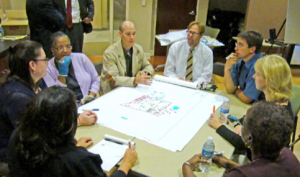
Public Charrette Process involving Dover stakeholders
Source: Renaissance Planning Group
Ideally, the jurisdiction should prepare a public engagement plan to identify who to involve, how to conduct outreach, and when public participation opportunities should occur throughout the planning process. A mix of high-touch engagement opportunities (e.g., workshops, open houses, charrettes, public hearings) and high-tech engagement strategies (e.g., online surveys, websites, and social media) should be considered to provide optimal public involvement in the planning process. All workshops, public hearings, meetings should be advertised and open to the public to uphold the Freedom of Information Act (FOIA).
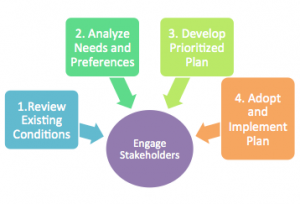 IPA’s publication, Healthy Communities: A Resource Guide for Delaware Municipalities, emphasizes the need to engage stakeholders and suggests a process, which may be modified to this four-step process for parks and recreation master planning:
IPA’s publication, Healthy Communities: A Resource Guide for Delaware Municipalities, emphasizes the need to engage stakeholders and suggests a process, which may be modified to this four-step process for parks and recreation master planning:
- Step 1: Review Existing Conditions
- Step 2: Analyze Needs and Preferences
- Step 3: Develop Prioritized Plan
- Step 4: Adopt and Implement Plan
Step 1: Review Existing Conditions
To plan for future parks and recreation needs, a jurisdiction needs to understand and assess the context of the planning area, environmental conditions, and existing conditions.
Research existing conditions and trends for population, socio-economic conditions, and other factors that may govern demand for parks and recreation facilities and programs. According to a Project for Public Spaces report, master plans contain the history of the park, the context surrounding its development, and describe the evolution of the park/park system over time. Background information should define the planning area, describe the planning process, and explain strategies for engaging and involving the public.
Conduct site inventories to obtain information on current environmental conditions. Information may be obtained from GIS mapping, site reconnaissance and visits to the area, or reviewing previous studies and historical information on a parks system. Information should be gathered on historical features and archeological research, soil conditions, vegetation, wetlands, topography, floodplains, riparian buffers, environmental issues, native flora and fauna, and endangered species.
Review permitted land uses to determine how the land, and adjacent property, is currently zoned and whether the intended use is permitted within the jurisdiction’s zoning code. If the land is not currently owned by the jurisdiction, the property should be researched to determine if there are any deed restrictions or easements that impose restrictions on the use of the land, regardless of the owner.
Conduct an inventory and analysis of current parks facilities and recreation programs. This information may be gathered during field visits to parks and recreation sites, focus group sessions, and interviews with municipal staff members, parks and recreation board members, other recreation providers, and stakeholders A narrative should be developed to describe facilities and programs in the recreation system, including programs and activities at each site, maintenance issues, preventive maintenance needs, and risk management issues. An inventory should be conducted of all public (e.g., school districts), non-profit (e.g., YMCA’s), and/or private recreation facilities and programs in the service area. A map should be prepared to identify where existing parks and recreation sites are located and distributed throughout at jurisdiction and where undeveloped land, with future recreation potential, is located.
Map data to determine both the existing and possible future locations of parks, open space and natural areas, and both passive and active recreation sites. Mapping should consider possible locations of “pocket parks,” defined as small outdoor spaces of less than ¼ of an acre in commercial, densely developed, or urbanized areas.
Address accessibility to ensure that parks and recreation facilities and programs provide equivalent opportunities and experiences for persons with disabilities. All local government park boards, departments, and facilities are covered by Title II of the Americans with Disabilities Act (ADA). It is important to identify any architectural, transportation, communication, or service barriers that may limit the use of parks and recreation facilities or programs by people of various abilities. Parks and recreation boards and departments should conduct an ADA self-evaluation and prepare a plan to remove barriers to program participation and use of facilities. ADA Standards and ABA Standards contain provisions for various types of recreation facilities. The U.S. Access Board has issued a series of guides on recreation facilities that further explain these requirements in the standards.
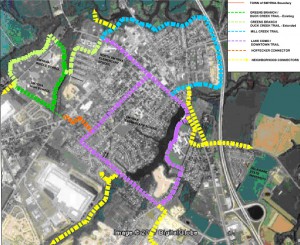
Smyrna Bike and Hike Master Plan
Source: LAS LLC
Step 2: Analyze Needs and Preferences
Public opinion is extremely important to guide local governments in the parks and recreation master planning process. There is no right or wrong way to analyze parks and recreation needs and preferences. Local governments should consider using a variety of “best practice” methods to ensure that information is gathered from a representative cross-section of local government stakeholders.
Review previous plans and studies – Past studies, and those conducted by outside organizations should be to guide local government parks and recreation master planning. Local governments should review information within the Statewide Comprehensive Outdoor Recreation Plan (SCORP), which is a planning and policy document that identifies needs in outdoor recreation throughout the state of Delaware. Prepared by DNREC, the SCORP is used to guide parks and recreation funding investment of funding for outdoor recreation based on the assessment on needs and preferences. Delaware’s SCORP is developed with input through a public telephone survey of Delawareans, and consultations with organizations and experts that are committed to quality outdoor experiences, healthy lifestyles, tourism and child advocacy. Local leaders may also wish to review a Nemours Health and Prevention Services (NHPS) a policy brief policy brief, Investment in Parks and Recreation is Necessary for Children’s Health, which identifies summarizes the SCORP and highlights the health benefits of outdoor recreation.
Assess Community Needs – Municipalities can also conduct their own research about local residents’ parks and recreation needs and preferences. This process can occur during scheduled workshops, public meetings, surveys, and stakeholder interviews, as well as digital engagement through social media and websites. In addition, the information gathering step will provide a technical assessment, identify existing deficiencies, and gauge existing use and demand for current municipal parks and recreation facilities.
Needs Analysis – A needs analysis should be conducted to provide a formal assessment of parks and recreation program and facility needs of the community. Local governments may wish to use needs analysis methods that have been sanctioned by national organizations. A preliminary level of service (LOS) assessment of facilities, based on the standards developed by the National Recreation and Park Association (NRPA), has been the traditional method used by most parks and recreation departments to analyze needs.
Since 2001, a revised methodology called composite-values LOS analysis or GRASP® (Geo-Referenced Amenities Standards Program) has been widely adopted. This method assesses the extent to which the location and conditions of facilities meets the needs and expectations of its residents and also takes into consideration other factors — such as convenience, ambience, and comfort. All are combined into a numerical index, displayed graphically on maps, and to determine the equity and deficiencies of the system as a whole, as well as of its individual parts.
The USDA Forest Service has established a Recreational Opportunity Spectrum that provides a framework, which may be used by parks and recreation professionals, to inventory recreational resources, estimate the consequences of management decisions, and to match experiences desired by recreationists with available opportunities.
Step 3: Develop a Prioritized Action Plan
Once the parks and recreation needs have been analyzed, key findings should be summarized. These findings will be the basis of developing a vision statement that charts the general course of the plan, identifies assets that need to be maintained, what needs to be changed, and how the plan will be accomplished. A prioritized action plan can then be developed that sets forth a series of goals, objectives, and recommendations to implement the vision.
The prioritized action plan should describe and rank-order priorities related to new or upgrades to existing:
- Facilities – including parks, open space system, greenways, recreation and community special-use facilities, or active transportation infrastructure (e.g., trail systems, bikeways, or shared-use paths)
- Recreation programs – such as recreation activities, classes, fitness and wellness programs, special events, and/or community festivals
- Management and operations – including implications for staffing levels, service levels, budgeting, capital improvements, maintenance and risk management plans, marketing plans, and technology improvements.
The action plan should include a matrix that describes the programs/projects, location, cost estimates, funding strategies and potential sources of funding, and year(s) of implementation. In addition, the action plan should provide a timeline, assigned responsibility for implementation, and evaluation metrics to guide development, capital improvements, and strategic initiatives for the next five years. Best management practices should be described such as partnering with other recreation providers, using volunteers to promote stewardship, adopting conservation and “green” environmental practices, outreaching to special needs populations, and instituting performance measurement programs.
If there is joint or shared ownership for a recreation facility, agencies should prepare a memorandum of agreement regarding ownership, operations, and maintenance. Opportunities for partnerships, volunteerism, and stewardship should be considered to provide support for ongoing maintenance and/or recreation programming.
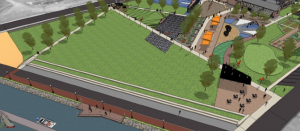
Delaware City Community Park & Trail Master Plan
Credit: Johnson, Mirmiran & Thompson; Toole Recreation Planners
Step 4: Adopt and Implement Plan
The final master plan is designed to serve as a decision‐making tool for local government officials to help set priorities for implementation and to provide a high level of parks and recreation services. The local government’s parks and recreation board, or the advisory committee involved in the master planning process, has a major role in advancing the plan for adoption. Prior to adoption by the governing body, a final public hearing should be advertised and held to give the public a final opportunity to provide feedback and comment.
The general cost estimates developed as part of the prioritized action plan will inform the jurisdiction’s operating budget and help identify capital expenditures. Capital projects are generally expenditures for infrastructure, buildings and facilities, equipment, and land. Expenditures for capital projects, are generally expensive (over a certain dollar amount), non-recurring, and have a useful life expectancy of more than one year. If a local government has not adopted a specific process for planning, budgeting, and financing capital expenditures, it should consider preparing a capital budget either as part of the annual operating budget or a separate process.
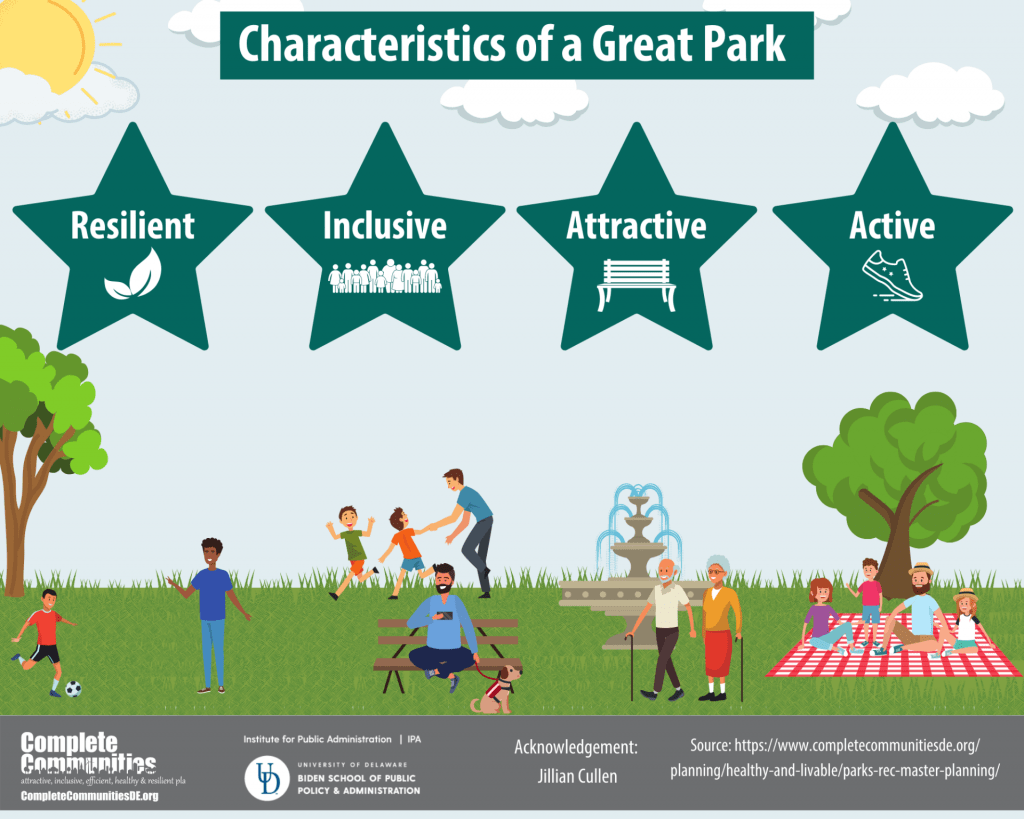
Common Issues with Parks and Recreation Master Planning
There are several issues that often arise when using master plans for parks and recreational facilities. By combating these issues early on, master planning can lead to success for all parties involved. Some of the most common issues with master plans, as stated in a Project for Public Spaces report include that parks and recreation master plans may be:
Inflexible
Master plans must be viewed as flexible guides instead of rigid plans. In certain situations, patrons and organizations believe that a master plan will not allow for changing conditions and desires. According to IPA’s Healthy Communities: A Resource Guide for Delaware Municipalities, master plans must be dynamic and flexible planning tools. They should set a framework for the future and evolve to adapt to changing community needs and goals.
Expensive
Creating master plans can be costly, especially if a consultant is hired. However, by pooling resources and expertise, the benefits of planning can greatly outweigh the costs.
Created and Not Used
It is important to keep all stakeholders involved during the entirety of the master planning process. If key players do not agree with the plan, it could fall to the wayside after completion due to lack of consensus.
Prepared without Sufficient Public Input and/or Congruence with Other Plans
The local jurisdiction has the discretion to prepare a master plan in-house, or with the help of an outside consultant. However, if a consultant is hired to oversee the process, opportunities for public input and feedback must be provided. Parks and recreation master plans should complement other state, regional, and local government plans; reflect the vision of the community; and be realistic in terms of a local government’s finances and funding sources.
Non-Compliant with ADA
The Americans with Disabilities Act (ADA) requires that newly constructed and altered state and local government facilities and places of public accommodation—including parks and recreation facilities—must be readily accessible to, and usable by, individuals with disabilities. The ADA Accessibility Guidelines (ADAAG) is the standard applied to buildings and facilities, including parks and recreational facilities.
Examples of Parks and Recreation Master Planning in Delaware
State of Delaware SCORP
Every five years, the State of Delaware’s Division of Parks and Recreation, within the Department of Natural Resources and Environmental Control (DNREC), is required prepare a Statewide Comprehensive Outdoor Recreation Plan (SCORP) in order to assess the public demand for, and supply of, outdoor recreation resources. A master plan itself, the SCORP analyzes the desires of residents of Delaware in regards to parks and other recreation facilities.
Delaware’s 2013-2018 SCORP summarizes the outdoor recreation preferences and anticipated facility needs generated by the recreating public. SCORP findings are essential in directing public outdoor facility investments that most closely match the public’s stated needs. Furthermore, SCORP findings are helpful in guiding planning decisions related to parkland placement, outdoor recreation issues, and planning for the public’s preferred recreation facilities.
State Park Master Plans
Produced by DNREC, The First State Trails & Pathways Initiative: Making Connections video highlights the First State Trails and Pathways Initiative that sets forth a plan to create an interconnected network of shared-use trails and pathways that will support safe and affordable, non-motorized travel and recreation opportunities. The planned trail network is designed to expand connections between neighborhoods, towns, and cities to create more vibrant, active, and healthy communities.
In addition, DelDOT prepared a Delaware Rail-to-Trail & Rail-with-Trail Facility Master Plan, with public input, in response to public interest in developing off-road facilities for bicyclists and pedestrians for both transportation and recreational uses. The Plan used SCORP data and reviewed select railroad corridors to identify segments that could be potentially suitable for re-use as shared-use Rail-to-Trail (RTT) and/or Rail-with-Trail (RWT) facilities. The Plan considered the interconnectivity of these potential rail-trail corridors with the existing and proposed statewide trail systems, greenways, and pedestrian/bicycle networks.
Local Government Parks and Recreation Master Plans
Delaware local governments may use outcomes of Delaware’s SCORP to inform parks and recreation planning processes at the local level. Information on recreation preferences within each of Delaware’s five SCORP regions may be used to guide master planning and local investments in open space, parkland acquisition, trails, and active passive recreation facilities and programs.
Because Delaware local governments provide services, programs, and facilities that meet the needs of citizens, it is important that parks and recreation master planning be conducted at the local level and reflect needs of community members. For example, in the City of Newark neighborhood parks have been established on small plots of land existing in established communities. They serve small segments of the population and have been developed with considerable input from neighboring residents who will use the facilities. Citizens can provide input as to whether the space will be used for active or passive recreation. Active recreation refers to structured recreational activities—such as sports leagues—that require specialized parkland development and management. Passive park use refers to non-organized recreational activities—such as hiking—that require no specialized parkland development, facilities, or management.
City of Newark
The City of Newark regularly involves the public in parks and recreation master planning, including the recent development of Curtis Mill Park. Located on a brownfield site of a former historic paper mill, the park is envisioned as a city gateway and will provide active and passive recreation as well as an expansion of the city’s pedestrian and bicycle network.
The City of Newark has also worked with the Delaware Department of Transportation and other stakeholders to prepare the master plan for its Pomeroy and Newark Rail Trail. Public engagement was critical to the planning process. Public meetings were held to garner citizen input both in person and via a form that solicited written comments and feedback. The trail serves both as a recreation facility and transportation facility that expands the existing pedestrian network to a Delaware state park, improves pedestrian safety and mobility, and provides a connection to park facilities and Newark’s central business district. Designated as a Bicycle Friendly Community by the League of American Bicyclists, the City of Newark joined with the Newark Bicycle Committee and WILMAPCO to create a 2014 Bicycle Plan that focuses on developing a bicycle network, policies, and programs within the City and also identifies desired links and nearby destinations.
City of Milford
The City of Milford’s Parks and Recreation Department has leveraged a combination of city, state, and federal funds—totaling $5.3 million over a 25-year period to master plan its Mispillion Greenway. The City has prepared a presentation that showcases the multi-phased project. Strong support from citizens, the business community, state and local officials has helped to achieve the vision of a greenway that provides a scenic, riverfront bicycle and pedestrian trail system, which provides a link to its business district and has inspired downtown reinvestment. The City of Milford has also created a Bicycle and Pedestrian Paths master plan to better serve its residents.
City of Dover
The City of Dover, in collaboration with the Downtown Dover Partnership and the Dover/Kent County MPO, has utilized master planning techniques to develop a bike trail system that connects its downtown to Silver Lake. This path connects key scenic and civic destinations and provides both recreation and active transportation opportunities. The City of Dover’s trail system is integrated within the Dover/Kent County MPO Regional Bicycle Plan for 2030.
City of Lewes
The City of Lewes revitalized its waterfront property through the development of the Lewes Canalfront Park and Marina. Spanning three acres adjacent to the Lewes and Rehoboth Canal, the park provides public boat ramps, a fishing pier, a boardwalk, and other amenities. Now open for uses such as leisurely walks and civic gatherings, the park was a sustainable master planning project undertaken by the City of Lewes with public input via workshops, surveys and interviews. The City of Lewes enlisted the consulting firm Andropogon to prepare the Canalfront Park and Marine Master Plan. This video showcases the scenic beauty of the park, which captures the character and history of the town and provides an opportunity to reconnect the historic town core to the waterfront.

